+ データを開く
データを開く
- 基本情報
基本情報
| 登録情報 | データベース: EMDB / ID: EMD-24572 | ||||||||||||||||||||||||||||||||||||
|---|---|---|---|---|---|---|---|---|---|---|---|---|---|---|---|---|---|---|---|---|---|---|---|---|---|---|---|---|---|---|---|---|---|---|---|---|---|
| タイトル | SP6-11 biased agonist bound to active human neurokinin 1 receptor in complex with miniGs/q70 | ||||||||||||||||||||||||||||||||||||
 マップデータ マップデータ | Unsharpened map | ||||||||||||||||||||||||||||||||||||
 試料 試料 |
| ||||||||||||||||||||||||||||||||||||
| 機能・相同性 |  機能・相同性情報 機能・相同性情報substance P receptor activity / tachykinin receptor activity / aggressive behavior / Tachykinin receptors bind tachykinins / positive regulation of flagellated sperm motility / positive regulation of uterine smooth muscle contraction / detection of abiotic stimulus / positive regulation of synaptic transmission, cholinergic / tachykinin receptor signaling pathway / operant conditioning ...substance P receptor activity / tachykinin receptor activity / aggressive behavior / Tachykinin receptors bind tachykinins / positive regulation of flagellated sperm motility / positive regulation of uterine smooth muscle contraction / detection of abiotic stimulus / positive regulation of synaptic transmission, cholinergic / tachykinin receptor signaling pathway / operant conditioning / positive regulation of lymphocyte proliferation / sperm head / response to ozone / sperm ejaculation / positive regulation of action potential / response to auditory stimulus / smooth muscle contraction involved in micturition / regulation of smooth muscle cell proliferation / positive regulation of hormone secretion / positive regulation of blood pressure / positive regulation of vascular permeability / positive regulation of ossification / regulation of smooth muscle cell migration / positive regulation of leukocyte migration / eating behavior / positive regulation of epithelial cell migration / behavioral response to pain / associative learning / PKA activation in glucagon signalling / angiotensin-mediated drinking behavior / hair follicle placode formation / developmental growth / D1 dopamine receptor binding / intracellular transport / sperm flagellum / Hedgehog 'off' state / long-term memory / adenylate cyclase-activating adrenergic receptor signaling pathway / activation of adenylate cyclase activity / response to electrical stimulus / positive regulation of vasoconstriction / sperm midpiece / positive regulation of stress fiber assembly / adenylate cyclase activator activity / positive regulation of epithelial cell proliferation / trans-Golgi network membrane / response to progesterone / positive regulation of synaptic transmission, GABAergic / response to nicotine / G-protein beta/gamma-subunit complex binding / bone development / Olfactory Signaling Pathway / Activation of the phototransduction cascade / G beta:gamma signalling through PLC beta / Presynaptic function of Kainate receptors / Thromboxane signalling through TP receptor / adenylate cyclase-activating G protein-coupled receptor signaling pathway / G protein-coupled acetylcholine receptor signaling pathway / G-protein activation / Activation of G protein gated Potassium channels / Inhibition of voltage gated Ca2+ channels via Gbeta/gamma subunits / Prostacyclin signalling through prostacyclin receptor / Glucagon signaling in metabolic regulation / G beta:gamma signalling through CDC42 / cognition / platelet aggregation / ADP signalling through P2Y purinoceptor 12 / G beta:gamma signalling through BTK / Synthesis, secretion, and inactivation of Glucagon-like Peptide-1 (GLP-1) / Sensory perception of sweet, bitter, and umami (glutamate) taste / photoreceptor disc membrane / Adrenaline,noradrenaline inhibits insulin secretion / Glucagon-type ligand receptors / Vasopressin regulates renal water homeostasis via Aquaporins / G alpha (z) signalling events / cellular response to catecholamine stimulus / Glucagon-like Peptide-1 (GLP1) regulates insulin secretion / ADORA2B mediated anti-inflammatory cytokines production / sensory perception of taste / ADP signalling through P2Y purinoceptor 1 / adenylate cyclase-activating dopamine receptor signaling pathway / G beta:gamma signalling through PI3Kgamma / cellular response to prostaglandin E stimulus / Cooperation of PDCL (PhLP1) and TRiC/CCT in G-protein beta folding / GPER1 signaling / G-protein beta-subunit binding / Inactivation, recovery and regulation of the phototransduction cascade / heterotrimeric G-protein complex / G alpha (12/13) signalling events / extracellular vesicle / sensory perception of smell / signaling receptor complex adaptor activity / Thrombin signalling through proteinase activated receptors (PARs) / Cargo recognition for clathrin-mediated endocytosis / GTPase binding / response to estradiol / retina development in camera-type eye / Clathrin-mediated endocytosis / Ca2+ pathway / positive regulation of cold-induced thermogenesis 類似検索 - 分子機能 | ||||||||||||||||||||||||||||||||||||
| 生物種 |  Homo sapiens (ヒト) / synthetic construct (人工物) / Homo sapiens (ヒト) / synthetic construct (人工物) /  | ||||||||||||||||||||||||||||||||||||
| 手法 | 単粒子再構成法 / クライオ電子顕微鏡法 / 解像度: 3.2 Å | ||||||||||||||||||||||||||||||||||||
 データ登録者 データ登録者 | Harris JA / Faust B / Gondin AB / Daemgen MA / Suomivuori CM / Veldhuis NA / Cheng Y / Dror RO / Thal D / Manglik A | ||||||||||||||||||||||||||||||||||||
| 資金援助 |  米国, 米国,  オーストラリア, 11件 オーストラリア, 11件
| ||||||||||||||||||||||||||||||||||||
 引用 引用 |  ジャーナル: Nat Chem Biol / 年: 2022 ジャーナル: Nat Chem Biol / 年: 2022タイトル: Selective G protein signaling driven by substance P-neurokinin receptor dynamics. 著者: Julian A Harris / Bryan Faust / Arisbel B Gondin / Marc André Dämgen / Carl-Mikael Suomivuori / Nicholas A Veldhuis / Yifan Cheng / Ron O Dror / David M Thal / Aashish Manglik /   要旨: The neuropeptide substance P (SP) is important in pain and inflammation. SP activates the neurokinin-1 receptor (NK1R) to signal via G and G proteins. Neurokinin A also activates NK1R, but leads to ...The neuropeptide substance P (SP) is important in pain and inflammation. SP activates the neurokinin-1 receptor (NK1R) to signal via G and G proteins. Neurokinin A also activates NK1R, but leads to selective G signaling. How two stimuli yield distinct G protein signaling at the same G protein-coupled receptor remains unclear. We determined cryogenic-electron microscopy structures of active NK1R bound to SP or the G-biased peptide SP6-11. Peptide interactions deep within NK1R are critical for receptor activation. Conversely, interactions between SP and NK1R extracellular loops are required for potent G signaling but not G signaling. Molecular dynamics simulations showed that these superficial contacts restrict SP flexibility. SP6-11, which lacks these interactions, is dynamic while bound to NK1R. Structural dynamics of NK1R agonists therefore depend on interactions with the receptor extracellular loops and regulate G protein signaling selectivity. Similar interactions between other neuropeptides and their cognate receptors may tune intracellular signaling. | ||||||||||||||||||||||||||||||||||||
| 履歴 |
|
- 構造の表示
構造の表示
| ムービー |
 ムービービューア ムービービューア |
|---|---|
| 構造ビューア | EMマップ:  SurfView SurfView Molmil Molmil Jmol/JSmol Jmol/JSmol |
| 添付画像 |
- ダウンロードとリンク
ダウンロードとリンク
-EMDBアーカイブ
| マップデータ |  emd_24572.map.gz emd_24572.map.gz | 115.8 MB |  EMDBマップデータ形式 EMDBマップデータ形式 | |
|---|---|---|---|---|
| ヘッダ (付随情報) |  emd-24572-v30.xml emd-24572-v30.xml emd-24572.xml emd-24572.xml | 30.3 KB 30.3 KB | 表示 表示 |  EMDBヘッダ EMDBヘッダ |
| 画像 |  emd_24572.png emd_24572.png | 50.2 KB | ||
| その他 |  emd_24572_additional_1.map.gz emd_24572_additional_1.map.gz emd_24572_half_map_1.map.gz emd_24572_half_map_1.map.gz emd_24572_half_map_2.map.gz emd_24572_half_map_2.map.gz | 116.1 MB 18.4 MB 18.4 MB | ||
| アーカイブディレクトリ |  http://ftp.pdbj.org/pub/emdb/structures/EMD-24572 http://ftp.pdbj.org/pub/emdb/structures/EMD-24572 ftp://ftp.pdbj.org/pub/emdb/structures/EMD-24572 ftp://ftp.pdbj.org/pub/emdb/structures/EMD-24572 | HTTPS FTP |
-関連構造データ
| 関連構造データ |  7rmiMC  7rmgC  7rmhC M: このマップから作成された原子モデル C: 同じ文献を引用 ( |
|---|---|
| 類似構造データ | |
| 電子顕微鏡画像生データ |  EMPIAR-10786 (タイトル: Cryo electron microscopy final particle stacks of Substance P-Neurokinin Receptor G protein complexes EMPIAR-10786 (タイトル: Cryo electron microscopy final particle stacks of Substance P-Neurokinin Receptor G protein complexesData size: 170.8 Data #1: Particle stack and final .star file for SP-NK1R-miniGs399 reconstruction [picked particles - single frame - processed] Data #2: Particle stack and final .star file for SP6-11-NK1R-miniGsq70 reconstruction [picked particles - single frame - processed] Data #3: Particle stack and final .star file for SP-NK1R-miniGsq70 reconstruction [picked particles - single frame - processed]) |
- リンク
リンク
| EMDBのページ |  EMDB (EBI/PDBe) / EMDB (EBI/PDBe) /  EMDataResource EMDataResource |
|---|---|
| 「今月の分子」の関連する項目 |
- マップ
マップ
| ファイル |  ダウンロード / ファイル: emd_24572.map.gz / 形式: CCP4 / 大きさ: 125 MB / タイプ: IMAGE STORED AS FLOATING POINT NUMBER (4 BYTES) ダウンロード / ファイル: emd_24572.map.gz / 形式: CCP4 / 大きさ: 125 MB / タイプ: IMAGE STORED AS FLOATING POINT NUMBER (4 BYTES) | ||||||||||||||||||||||||||||||||||||||||||||||||||||||||||||||||||||
|---|---|---|---|---|---|---|---|---|---|---|---|---|---|---|---|---|---|---|---|---|---|---|---|---|---|---|---|---|---|---|---|---|---|---|---|---|---|---|---|---|---|---|---|---|---|---|---|---|---|---|---|---|---|---|---|---|---|---|---|---|---|---|---|---|---|---|---|---|---|
| 注釈 | Unsharpened map | ||||||||||||||||||||||||||||||||||||||||||||||||||||||||||||||||||||
| ボクセルのサイズ | X=Y=Z: 0.835 Å | ||||||||||||||||||||||||||||||||||||||||||||||||||||||||||||||||||||
| 密度 |
| ||||||||||||||||||||||||||||||||||||||||||||||||||||||||||||||||||||
| 対称性 | 空間群: 1 | ||||||||||||||||||||||||||||||||||||||||||||||||||||||||||||||||||||
| 詳細 | EMDB XML:
CCP4マップ ヘッダ情報:
| ||||||||||||||||||||||||||||||||||||||||||||||||||||||||||||||||||||
-添付データ
-追加マップ: Sharpened map
| ファイル | emd_24572_additional_1.map | ||||||||||||
|---|---|---|---|---|---|---|---|---|---|---|---|---|---|
| 注釈 | Sharpened map | ||||||||||||
| 投影像・断面図 |
| ||||||||||||
| 密度ヒストグラム |
-ハーフマップ: #1
| ファイル | emd_24572_half_map_1.map | ||||||||||||
|---|---|---|---|---|---|---|---|---|---|---|---|---|---|
| 投影像・断面図 |
| ||||||||||||
| 密度ヒストグラム |
-ハーフマップ: #2
| ファイル | emd_24572_half_map_2.map | ||||||||||||
|---|---|---|---|---|---|---|---|---|---|---|---|---|---|
| 投影像・断面図 |
| ||||||||||||
| 密度ヒストグラム |
- 試料の構成要素
試料の構成要素
+全体 : Substance P bound to Neurokinin 1 receptor-miniGs/q70 complex
+超分子 #1: Substance P bound to Neurokinin 1 receptor-miniGs/q70 complex
+超分子 #2: Guanine nucleotide-binding protein G(s)/G(q) subunit alpha hybrid
+超分子 #3: Guanine nucleotide-binding protein G(I)/G(S)/G(T) subunit beta-1/...
+超分子 #4: Substance-P receptor
+超分子 #5: Substance P 6-11
+超分子 #6: Nanobody 35
+分子 #1: Guanine nucleotide-binding protein G(s) subunit alpha isoforms sh...
+分子 #2: Substance-P receptor
+分子 #3: Substance P 6-11
+分子 #4: Guanine nucleotide-binding protein G(I)/G(S)/G(T) subunit beta-1
+分子 #5: Guanine nucleotide-binding protein G(I)/G(S)/G(O) subunit gamma-2
+分子 #6: Nanobody 35
-実験情報
-構造解析
| 手法 | クライオ電子顕微鏡法 |
|---|---|
 解析 解析 | 単粒子再構成法 |
| 試料の集合状態 | particle |
- 試料調製
試料調製
| 緩衝液 | pH: 7.5 |
|---|---|
| グリッド | モデル: Quantifoil R1.2/1.3 / 材質: GOLD / メッシュ: 300 |
| 凍結 | 凍結剤: ETHANE / チャンバー内湿度: 100 % / チャンバー内温度: 277 K / 装置: FEI VITROBOT MARK IV |
- 電子顕微鏡法
電子顕微鏡法
| 顕微鏡 | FEI TITAN KRIOS |
|---|---|
| 特殊光学系 | エネルギーフィルター - 名称: GIF Bioquantum / エネルギーフィルター - スリット幅: 20 eV |
| 撮影 | フィルム・検出器のモデル: GATAN K3 (6k x 4k) / 平均露光時間: 5.9 sec. / 平均電子線量: 67.0 e/Å2 |
| 電子線 | 加速電圧: 300 kV / 電子線源:  FIELD EMISSION GUN FIELD EMISSION GUN |
| 電子光学系 | 照射モード: FLOOD BEAM / 撮影モード: BRIGHT FIELD |
| 実験機器 |  モデル: Titan Krios / 画像提供: FEI Company |
 ムービー
ムービー コントローラー
コントローラー



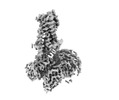



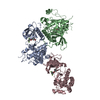
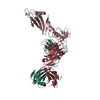




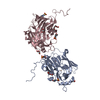
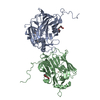






















 Z
Z Y
Y X
X

























 Trichoplusia ni (イラクサキンウワバ)
Trichoplusia ni (イラクサキンウワバ)

